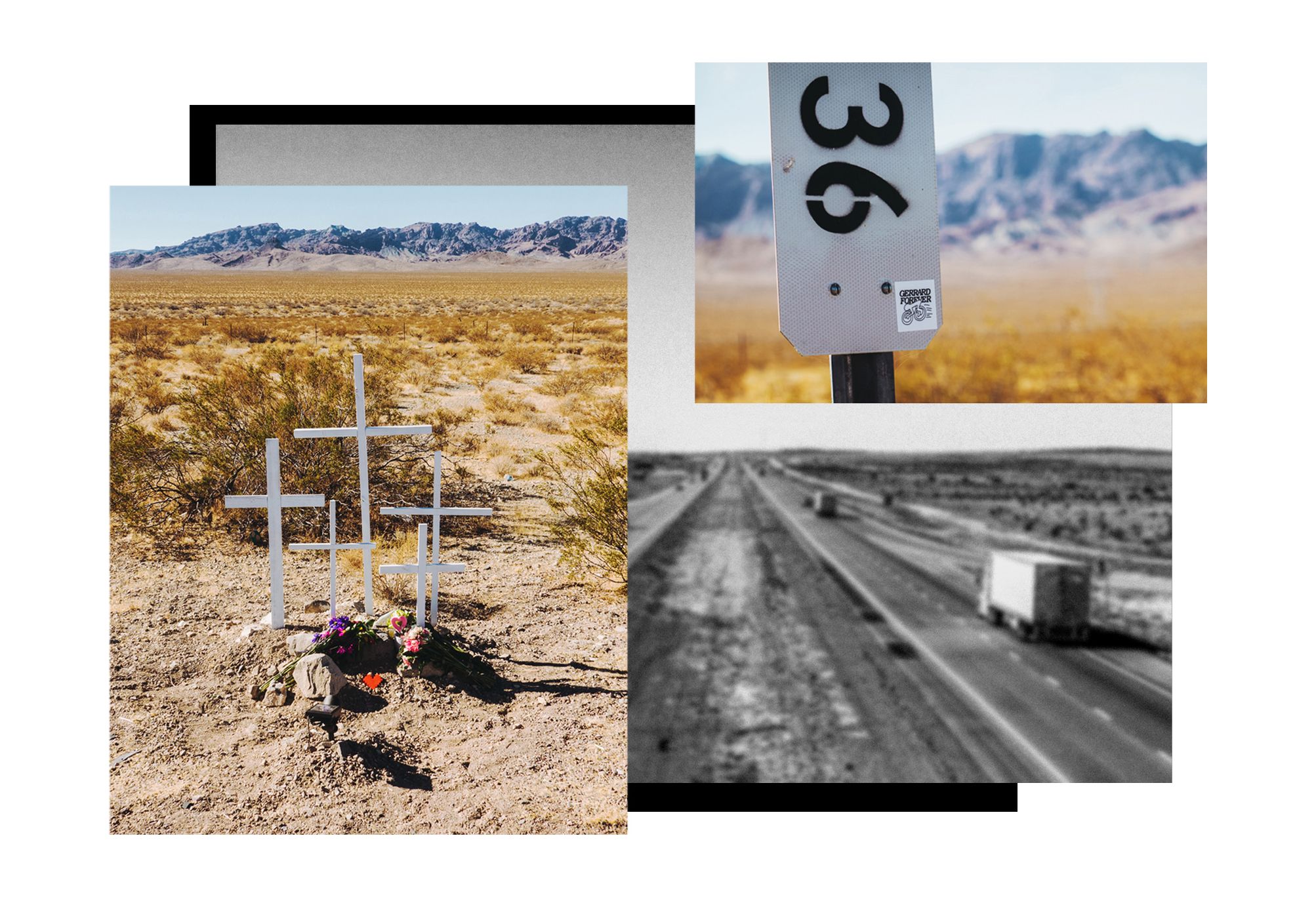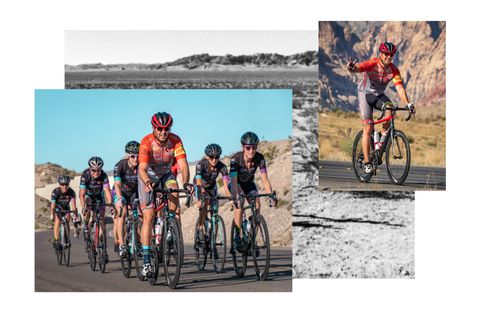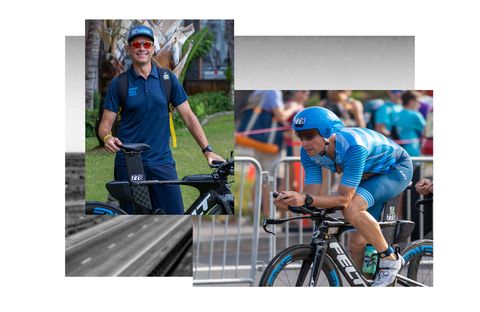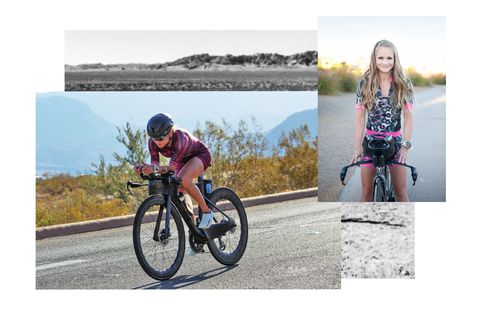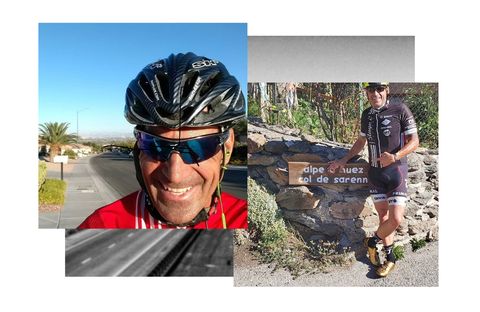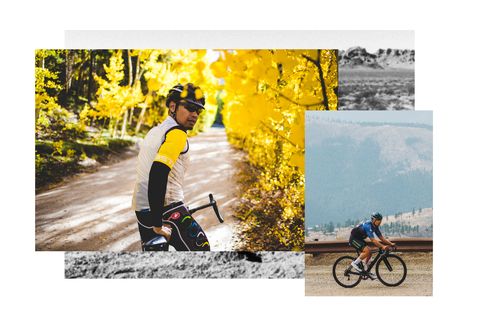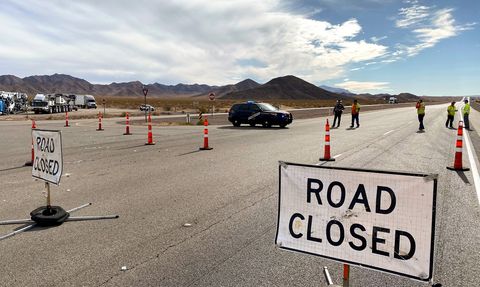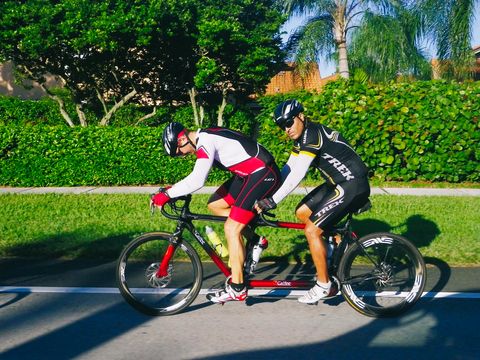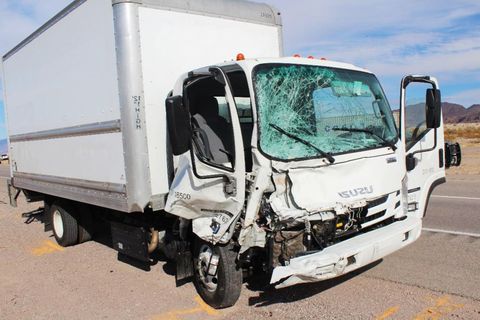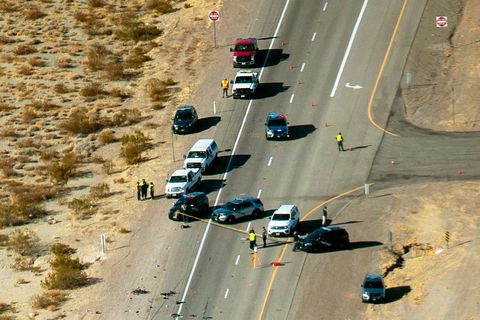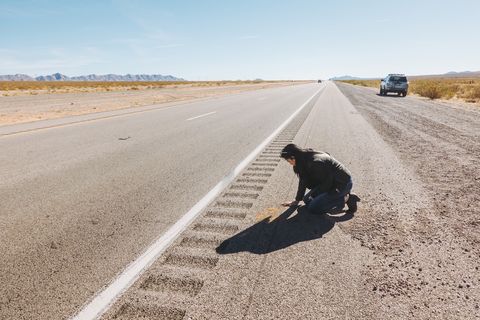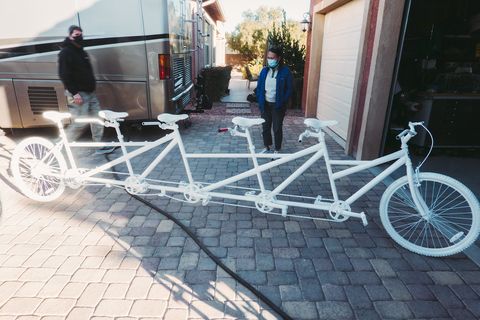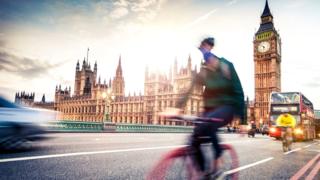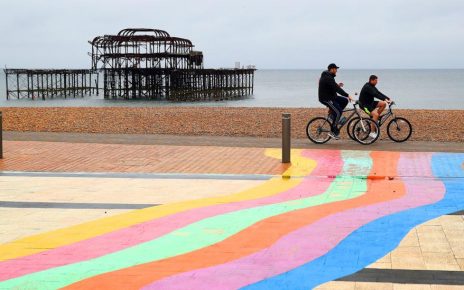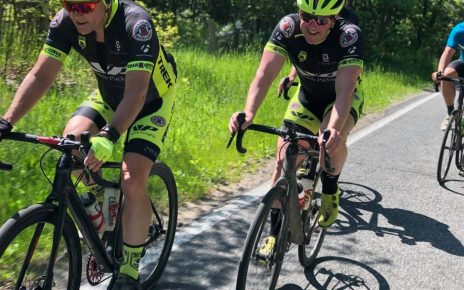It was chilly as the cyclists gathered at first light at the M Resort in Henderson, Nevada. Early morning rollouts are common in summer to avoid the searing desert heat, but on this December day, the group had another reason for a dawn departure: the Nipton Loop.
An annual tradition in the hard-core Las Vegas riding community, the Nipton Loop isn’t a regular training ride: It’s 125 miles of rugged, rolling, basin-and-range country, exposed to near-constant desert wind. Once you reach Searchlight, there are no bailout points, no shortcuts if the legs don’t feel good.
There was little chance of that in this group. Shawn McWilliams, a veteran marathon runner and relatively recent convert to road cycling, joined the ride with a friend. He planned to turn around at Searchlight for an out-and-back century. At the start, he only knew a couple of riders personally, but recognized others, locally famous on Strava. “They were all shooters,” he says.
They included several Category 1 and 2 racers, like Joseph Garey and Michael “Chikken” Anderson, longtime Vegas locals who had been doing the ride for years. Also in the group was a pair of strong triathletes: the fierce, pint-sized Erin Ray, who held a pro license, and Tom Trauger, a 57-year-old hammer with multiple top-five age group finishes at Ironman World Championships. Gerrard Nieva and Mike Murray were there, local Masters racers who were always up for a fast, competitive group ride. And Aksoy Ahmet, a recreational rider and full-time dad who joined practically every group ride he could find.
They got going at 7:15, slightly delayed by the usual futzing before any big ride. James Emery, a Cat 3 cyclist and sub-three-hour marathoner, started at the back of the group and rolled his way to the front, counting as he went. They were 20—more than most years—celebrating Garey’s recent birthday and Chikken’s retirement from a 22-year career with the Las Vegas Metro Police.
The ride was fast from the start as the pack hummed through the sleepy suburb of Henderson. “Everybody was on it,” says McWilliams. “I’m usually one to take some video and photos, but I couldn’t even find a spot to get my phone out.” Dave Merrill, a friend of Erin’s and several other riders, followed in a white Subaru Outback with its flashers on. The support vehicle was a pandemic-inspired novelty; the lone general store in the tiny town of Nipton, where the group usually stopped to refuel just past the halfway point, was closed.
An hour in, the group turned onto U.S. 95. From the outskirts of Henderson, the road drops south in a near-straight line into the Eldorado Valley, a broad, sparsely vegetated plain between two long ridges. After a fast 10 miles, it passes the Nelsons Landing turnoff and begins a gradual, 26-mile climb to the old gold mining boomtown of Searchlight. A four-lane divided highway with a 75 mph speed limit, U.S. 95 is nonetheless relatively quiet on weekdays. On a clear day like that Thursday, you can see for miles, your eye drawn to the impossibly bright gleam from the parabolic concentrators of Nevada Solar One, part of 4,000 acres solar generation facilities.
Turning over a brisk pace in a fast-rotating double paceline, the group passed the turn to Nelson’s Landing. Garey noticed an abrupt temperature bump, accompanied by a rising headwind. The pace hardly slowed; with a late start, 125 miles, and less than 10 hours of daylight, Nipton isn’t a ride you want to soft-pedal. The group started to crack under the pressure.
McWilliams, reveling in the power and fluidity of the rotation, felt a spasm in his calf. Man, I have 60 miles to go, he thought of his out-and-back plan. I should probably budget myself. Riders began to drop, and McWilliams sat up too. The wind rose to 15 mph, and shifted to a left cross that limited shelter from the draft. Between the wind and the gentle but persistent gradient, the reduced lead group split in two, with a front selection of 10 riders, including Chikken, Emery, Garey, and a few others. The second pack of seven more was slightly farther back.
Garey, then the service manager at Las Vegas Cyclery, normally would be driving the pace at the front. But he hadn’t ridden much lately, and he was starting to feel the effort. “I wasn’t having fun anymore, and I knew there were some really great riders behind,” he recalls. So, along with his friend Max Sanchez, he let the front group go.
The pair were shortly overtaken by the chase, pedaling perhaps a couple hundred yards behind the leaders. In a twist, Merrill’s support car now led this second group, riders arrayed behind it in a double paceline for maximum protection from the wind. On the left, Gerrard was closest to the Subaru, with Tom, Mike, and then Aksoy on his wheel. Garey and Sanchez drifted back past the right paceline: Jerome Ducrocq, Erin, and Jose Vasquez. Jose sat slightly to the right of Erin’s rear wheel. He did that regularly, says Garey, as if he wanted to give himself a bailout to dodge a dropped bottle or other obstacle.
Garey and Sanchez had no sooner settled behind Jose when a large white blur exploded into Garey’s peripheral vision like a bomb. He flinched: A semi? Oh man, this is it. My life is done, he thought. There was no warning, no screech of tires braking or horn blaring; the soft buzz of tires and drivetrains against the wind was instantly replaced with the loudest sound he had ever heard. He closed his eyes, bracing for an impact that never came. He opened them a moment later and as he skidded to a halt, a terrible silence settled over the scene like a shroud.
• • •
Angela Ahmet met her husband, Aksoy, on the Carnival Destiny cruise ship. She ran the casino and the first thing she noticed about him was his laugh booming across the room. Aksoy’s dice tables were popular with guests. “He was always joking, having fun, but he managed to keep a straight face. People don’t realize right away that he’s taking the mickey. He’s got the cheekiest grin.” Looking through the old cruise ship photos again, she remarks, “In every single one, Aksoy is smiling.”
But staying fit when you work on a cruise ship is hard. Aksoy crammed gym sessions at odd hours; Angela squeezed in quick runs at ports of call. When Angela got promoted to shoreside in Florida and their daughter Jasmine was born, it made the most sense for Aksoy to leave work to care for Jasmine until she was old enough for Carnival’s day care.
Living ashore meant Aksoy could ride. He soon bought a Cannondale and began showing up to the Saturday rides in Miramar, hammerfests of 50-odd riders on fast, flat out-and-backs through Pembroke Pines and along the marshy borders of the Everglades. This is where he met Jorge Peña, a fixture on the local road cycling scene. As he got fitter, he jumped into the weekday outings that Peña led: smaller, tight-knit packs of around a dozen who’d ride and go to lunch afterward. Even after Jasmine was joined by twin brothers, Emre and Eren, in 2007 Aksoy rode with Peña four or five days a week.
Like Aksoy, Tom Trauger, 57, didn’t even start riding bikes until he was well into adulthood—42, in fact. He’d been a gifted athlete as a kid; growing up in Wisconsin, he speed skated at the same facility as Eric Heiden and other Olympians, and he harbored his own Olympic dreams until the family moved to Southern California. But he put sports mostly aside in college.
Tom met Donna Pezzulo at the Las Vegas office of Arthur Andersen in 1995. They were colleagues first, then friends, then more. “I always say Tom was the senior manager, but it didn’t take long for me to become the boss,” Donna says with a laugh. Soon, they were drawn to the Bay Area by a shared love of good food and wine, but Tom, now at Ernst & Young, began to feel a different kind of pull. Being a partner at a legacy accounting firm was stressful. Long hours aside, his role in client recruitment wasn’t the healthiest lifestyle. It was “a lot of fancy lunches and big dinners, entertaining clients,” as Donna puts it. He was juggling work and family, including shared custody of Tom Jr. and Sarah, his children from his first marriage. His only exercise was golf. In 2001, at a corporate 5K for Donna’s work, Tom— now pushing 200 pounds—was jokingly mortified to get passed by a 10-year-old kid. Around the same time, a colleague collapsed in the office from a heart attack.
Leaving Big Five accounting was one way to rebalance his life, so Tom started consulting. In 2006, he began working with Sports Basement, a Bay Area chain of outdoor gear stores, which he later joined full time as CFO. A gift subscription to Triathlete magazine from his brother offered a path to better health—and a new obsession. Whether it was his single-digit handicap golf game or just buying a new coffee machine, Tom never did anything halfway. He began peppering his new colleagues, with questions about gear, training, anything that would improve his performance. He entered his first tri, the prestigious Wildflower Long Course (a 1.2-mile swim, 56-mile bike, 13.1-mile run) just months after picking up the sport, and finished 54th in his age group out of 251. It was a highly respectable first outing, but not good enough for Tom; the winner beat him by an hour. “He was calculating, ‘Where can I pick up this time? How is it possible to get an hour faster?’” says Donna.
If Tom was competitive and athletic, he had nothing on Erin Ray, 39, a serial sports junkie raised mostly in the Salt Lake City area. “I first noticed her competitive streak when she was 2,” says Erin’s mother, Ellen Leis. After coed T-ball, Erin was upset to learn she couldn’t keep competing against the boys in baseball. “She was self-aware, knew what she wanted, and didn’t take no for an answer,” says Leis. “She didn’t back down to anybody.” In high school, her soccer coach cut her from the team. She went back to practice every day until he relented and gave her a spot. “She was just determined to be part of the team, and she was definitely going to make it happen,” her mother says.
Erin did everything from gymnastics to karate growing up, and when she moved to Vegas as a young adult, she kept experimenting. She got her scuba certification, entered barrel races, even did competitive bodybuilding. One day, her gym held an indoor triathlon. It was a pool swim followed by a stationary bike leg and treadmill run. On a lark, Erin entered and won. Triathlon offered something she hadn’t had since soccer: a sport that suited her athletic talents and her competitive drive.
James Emery laughed the first time he rode with Erin on a group ride. “Who is this little pistol, 5-foot nothing and full of vinegar,” he wondered. Erin would go straight to the front of the group, then off it, and miss the turn. “She wanted to beat you so bad, she didn’t care that she’d made a wrong turn.” Then she’d just chase back on and do it again.
Mike Murray, 57, didn’t lack drive either. It just manifested differently. Raised in Vegas and the youngest of six kids, “Michael was a darling boy,” says his sister, Annette Brown. He was also a handful: hyperactive, mischievous, and like a twin to his brother and frequent co-conspirator Jeffrey, 13 months older. One day, they rolled the family car down the street. “One would work the gas pedal and the other would steer,” Brown recalls.
Mike raced motocross as a kid, but when he came back to it years later, he broke his hip in a bad crash, which led to a physical therapist’s rehab recommendation: ride bikes. An old friend introduced him to her husband, Eric Broussard, who worked at several Las Vegas shops until recently opening his own, Bike Brain. Come out on the Saturday ride, Broussard suggested. Mike did, and promptly got dropped. “But he was so competitive, he made it his mission to figure out how to survive,” says Broussard. Mike became a regular on the Saturday ride and its core, a tight circle of seven who loved to trash talk each other and informally referred to themselves as “the crew.”
For an ex-motocross racer, Mike wasn’t much of a bike handler at first, Broussard remembers thinking. He was a stylish rider, always with the coolest sunglasses, but he had a tendency to go straight off into the dirt if he wasn’t paying full attention. The crew loved to give him grief about it. On climbs, he’d battle back and forth with the much larger Broussard, each fighting to beat the other, if even by half a wheel. But he stuck with it, joining the Southern California team Stage 2. Eventually, Broussard had to admit that the competition between them was over, at least on climbs. Ernie Sanchez (no relation to Max), Mike’s friend and Stage 2 cofounder, agrees: “The last few years, Mike improved phenomenally, from pack finisher to podium,” he says. Sanchez keeps a photo of Mike from the 2020 Victorville Criterium, where he podiumed in the 55+ open class. It was his last race before the pandemic.
Crits were also a big part of Gerrard Nieva’s life, where the 41-year-old was a member of the Carefast team. But his path to the start line began far away in the Philippines, where Gerrard spent his first 12 years with his younger brother, Donalrey (Don), and sister Ria. Their mom immigrated to Las Vegas in 1985, when Gerrard was just seven.
One by one the siblings joined her, one year apart; first Ria in 1990, then Gerrard, and finally Don. The boys skipped the whole American ball sports thing. Instead they explored pop culture like sneakers, graffiti art, and DJ’ing, buying vinyl and listening to Invisibl Skratch Piklz, the Beat Junkies, and other West Coast artists. In 2006, on vacation in Hawaii, a family friend rolled up to meet them at their hotel on a fixie. Gerrard was transfixed.
He quickly bought his own, a Mercier Kilo TT, and the brothers immersed themselves in the nascent Vegas fixie scene. Gerrard was always a pretty big kid, Don recalls: 260 pounds at one point, a lot on a guy who stood only 5-foot-8. To lose weight, Gerrard adopted the so-called Fight Club diet, a fad from the movie starring Brad Pitt that paired stringent caloric restrictions with heavy gym workouts and cheat days. “Literally at midnight we’d go to a casino café that was open, and eat everything,” Don says, laughing. Bikes, even the 10-mile rides the fixie crew went on, helped Gerrard steady his diet and exercise. Ten miles became 20, and then 40, which led to road bikes. Gerrard dropped 100 pounds.
Gerrard’s sense of style carried over to road riding. He fastidiously cleaned his bike and his favorite shoes, a pair of white Giro Empire SLXs. Emery remembers driving to a race with him in 2017. At the start, Gerrard pulled a brand-new pair of gleaming white Swiftwick socks from their packaging, a tradition. “New socks on race day,” he would say. “At the very least I’ll look good out there.”
• • •
While many people in Las Vegas ride bikes for transportation, the enthusiast road riding community is perhaps a few thousand in number—not large for a metro area of 2.3 million. But it is close-knit. Almost all the cyclists I spoke with knew, at least casually, each of the riders who became known as the Las Vegas Five. And group rides are a vital part of its fabric.
Some of that is the perception of safety in numbers. Adapted to the slow car speeds of dense New York City, Don was taken aback by drivers’ habits on the wide suburban roads when he rode with his brother. “The riding is beautiful, but I was intimidated because all speed limits are, like, 45,” he says. The always-open gaming economy makes for constant traffic as workers commute at all hours. Other riders tell stories about regularly being yelled at, and describe a broad narcissistic impatience common to drivers. When he takes his 3-year-old son to the park near an elementary school, James Emery says, “Guaranteed, we will have to wait for two or three cars to blow the crosswalk before we can go. Everyone’s in such a hurry, and they just don’t care. They don’t see us as human beings; we’re an obstruction to them getting to where they need to go.”
Two of Vegas’s most popular riding areas are around Red Rock Canyon National Conservation Area, on the west side near Summerlin, and the Lake Mead National Recreation area, on the east side near Henderson. Both suburbs are newer, and bike lanes (mostly conventional, not protected) are fairly common. But much of the rest of Las Vegas, a sprawl bisected by Interstate 15 and the Strip, is far less hospitable. Red Rock, especially, has seen an increasing amount of car traffic from park visitors. Riders I spoke with said they generally felt safer with the higher visibility of a group. But some of Vegas’s social riding dynamic is far simpler. Sometimes we just need the easy company of people like us, to feel like we’re in a place where we belong.
Erin Ray was always doing group rides, sometimes to the chagrin of her coach, the former pro cyclist Iván Domínguez. Triathlon’s rigorous swim-run-ride training blocks emphasize disciplined workouts often best done solo. Domínguez says the lure of group rides is a constant pressure for clients, but with Erin especially, “It was always a battle.”
Often she’d defy the coach’s instructions, joining groups three or even four days a week. “I’ll just hop in the back,” she’d say, bargaining with him. That’s where she met Emery, a fellow runner who also loved the camaraderie of group rides. “Running can be social, but unless you find someone with an almost identical ability, you can’t stick together training,” he says.
Erin moved to Vegas not long after high school for a job as a nanny, which led to a series of jobs before she found her calling in real estate. So she had to build her own community through sports and work. A realtor, she most loved those alchemic moments when a couple stepped into a house and saw their life there: holiday dinners, family movie night, a home. She sought that in cycling. And her relentless competitiveness had a flip side, observes her mother, Ellen Leis: “That’s what everyone saw, but underneath there was a vulnerability. She was always open, willing to put herself out there. She would be as happy for friends in their achievement as she was for her own. She was the loudest cheerleader at the finish line.”
Gerrard’s first group rides, in 2006, were urban fixie rambles; he began road riding four years later. His brother had already moved to New York, partly for a burgeoning photography career (Don has shot for Rapha and other cycling brands). With 2,500 miles between them, Don realized that for their entire childhood, he’d taken cues from his kuya, a Filipino honorific for a respected older brother. He’d learned how to dress to fit in, the cool things to say. Road riding was the first thing they explored independently.
Emery calls Gerrard an uncommonly selfless teammate, always willing to sacrifice his own chances to keep a teammate up front. His wife, Cristina Gonzales, says he was quiet. She met Gerrard in 2006 at the dialysis facility where they worked; she was a team leader nurse, he was a technician. It was three years before he said more than a few words to her. But his shyness disappeared once he began to show his interest. He was patient and persistent. Once they started talking, he deflected her attempts to set him up with a niece, asking Cristina to dinner instead. “One day, you will love my awesomeness,” he told her with giddy confidence after an early date. She kissed him and told him she already did. They were together from that moment on.
Aksoy Ahmet loved the edge of a competitive group ride, but he wasn’t a racer. He could turn the switch on and off, says Angela. On no-drop rides, he’d be at the back making sure everyone stayed on and had fun. Not long after Aksoy and Jorge Peña started riding together in Florida, Peña started to lose his eyesight due to a degenerative condition called retina pigmentosa. Aksoy suggested a tandem and became Peña’s favorite pilot. Just like on singles, they’d crack jokes and jump the gap to a breakaway, working as a team. Peña, relieved of the responsibility to stay up front and direct the group, discovered another perk: he could finally just sit in and chat. “Because of Aksoy, I met people I wouldn’t have otherwise,” he says.
Soon after they moved to Las Vegas in 2015, Aksoy rode the Tour de Summerlin, an organized ride that is now a fundraiser for Breakaway Cycling, the largest recreational riding club in the area. He hung with the front group until the big climb, then fell in with another dropped rider: Mark Weimer, Breakaway’s co-founder. “We spent the whole day together, just laughing, telling jokes, sprinting for signs,” Weimer says. They became instant fast friends. The Ahmets joined Breakaway, and when Aksoy learned about the club’s work donating bikes to area school kids, he jumped into that too. “Every event, 15 to 20 a year, he volunteered,” says Weimer. “Most of these kids are from tough backgrounds. They don’t always know a lot of love. And he’d get with these kids and, just like with his own, he’d light up to share his passion. It was incredible to watch.”
The bike knowledge that Tom Trauger soaked up through Sports Basement got redirected outward too. He was known for cleaning his teammates’ bikes as obsessively as his own. At the 2013 Vineman Triathlon, recalls teammate John Savage, one team member’s bike didn’t arrive in time. In the middle of his own race prep, “Tom took it on himself to find a bike, build it, size it, and get it totally ready so he could compete,” says Savage.
“Some people are so wound up before the race,” says Tom’s coach Nate Helming, “but Tom would joke. He’d have a glass of wine with dinner while other people are packing broccoli and chicken to the airport.” Every fall, after the last race, it was Wine Season, two blissful months of Napa Valley trips and eating out with Donna, when Tom didn’t worry about training.
An original member of the Every Man Jack triathlon team, Tom was always the oldest by a couple of decades. It was a fact his teammates rarely missed an opportunity to mention, says his friend and fellow triathlete Ritch Viola, founder of both the team and the men’s grooming brand that sponsors it. Tom never used his age as an excuse for getting dropped—“We’d be pushing hard and he was still making jokes,” says Adam Carlson, another founding member of the team. But he also took his senior role seriously. “He had so much more life experience,” recalls Viola, who was grateful for what he calls Tom’s “investment” in his fellow athletes.
Tom’s mentorship wasn’t just about bikes. “I ride with a lot of people, but very few I’d consider as training partners,” says Carlson. Before the Traugers moved back to Vegas part time, Tom went on regular Saturday training rides with Carlson. On those long rides over the Berkeley Hills to Port Costa, Carlson sought Tom’s advice on matters like taking over his uncle’s law firm, buying a house (real estate was Tom’s other hobby), and relationships.
Donna embraced that, too. “I love to cook and bake,” she says. “That’s my thing.” So when Tom volunteered to organize annual team training camps in Vegas, Donna planned meals, shopped, and cooked for 50 triathletes. (“So, like 100 normal people,” she jokes.) Team camp always had a night out on the Strip. No gambler, one year Tom stepped up to a blackjack table and put his analytical mind to work. He won $400 in a few quick rounds, and cashed out just as fast in front of astonished teammates. On the drive home, when dozens of hungry racers hit the In-N-Out, Tom pulled out his winnings. “I got this,” he said.
For Mike Murray, riding provided support and solace of a different kind. In addition to rehabbing his hip, Mike was a recovering alcoholic. In 2002, he had moved back to Vegas after a relationship ended, and was tending bar and taking care of his brother Jeffrey, who’d been badly injured in an industrial accident. He was still addicted at the time, and increasingly desperate about it. “I’m in hell,” he told his sister. “These places aren’t good for me.”
Not long after that, sobriety hit Mike like a lightning bolt. But then so did the motocross crash that broke his hip. Brown feared a relapse. “You’re older now, you’ve had some addictions, what do you do? You get back on the drugs or find something else,” she said. As it happened, there were two “something elses.” One was Alcoholics Anonymous. Mike almost never missed a meeting, barely even a day, in an unbroken 17-year streak of sobriety. The other thing was riding bikes, which Mike took to with equal determination. “As an addict, everything you do, you do full bore,” Brown observes.
“Mike had demons,” says his close friend, Broussard. “I realized with Mike, he needed to have a lot of fun, because he gave up a lot. Addiction is everything, and so he needed fun and laughter and adrenaline, the therapy of being out there two or three hours to think.” Mike loved to banter on rides, always cracking up at his own jokes. At stoplights, he’d flex his legs and smirk self-knowingly at Broussard. (“Who has legs like this?”) He’d jokingly lavish praise on his old Fuji Transonic, which Broussard begged him to upgrade. On the Park to Park Pedal century one year, two other riders crashed and brought Mike down just a few miles in. Bloodied and banged up, he fought to finish the ride while dishing out a nonstop stream of self-congratulatory commentary. “I’m tough as nails,” he told Broussard. “You should just call me Nailz.” They laughed; no one gives themselves their own nickname, right? But it stuck.
Mike’s brashness was always self-joking. If you paid attention, he had a thoughtful, deeply spiritual side too. “Mike was a soulful guy,” Broussard says. When preparations to open Bike Brain in 2019 forced Broussard to miss a planned riding trip in France, Mike went alone and came back with rhapsodic tales of solo climbs in the Alps. Mike had a lot of facets, his sister observes, an ease and comfort in company from all aspects of his life, from punk rock to bikes. He talked excitedly about faith with Ernie Sanchez, a fellow member of the Church of Jesus Christ Latter-day Saints, for example, but never mentioned his sobriety. (“I’d have given him a hug and told him I respected him even more,” says Sanchez.) But it was the bike that grounded him. If AA gave him a path out of addiction, the bike was his vehicle to follow it, to finally be free. “Michael wasn’t very active in the church, but he had a very personal spirituality,” says Brown. “I think he found that on the bike.”
On U.S. 95, as the group began to stretch under pressure, no one can say for sure why the riders in the second group ended up there. Maybe Erin and Jose and Jerome were metering their efforts for a long ride. Maybe Aksoy and Gerrard, selfless and always looking out for others, decided to hang back. “I don’t think Aksoy was weaker than the guys at the front,” says Angela Ahmet. “I think he went back to help, because he would’ve gone back to help me in that wind.”
Maybe the oldest—Tom, in full Wine Season, and Mike, 10 months from his last race—wisely decided that the third hour of a seven-hour ride was not the time to burn precious matches trying to hang with the young chargers. However the second group came together, once it did, they were a pack, a community like any other. The last thing Chikken remembers before the main bunch split apart was Tom telling Erin as they drifted back, “I got you.”
• • •
When Shawn McWilliams felt the cramps coming on halfway to Searchlight, he knew he needed to dial back the pace. He told Joseph Garey he’d reconnect with the crew in town, and dropped off the back. His friend Kyle Larson soon joined him, and the bunch quickly drew ahead until they were out of sight.
Minutes later, he saw unusual shapes on the road in the distance. Drawing closer, he made out three trucks blocking the entire road and shoulder. As any roadie knows, there’s always debris on the paved shoulder: shredded tires, spare bolts, trash. But it wasn’t until McWilliams rode past part of a carbon-fiber wheel that the awful truth dawned on him. This is pieces of us, he realized.
Up ahead, James Emery had dropped off the lead group when a red Chevy Silverado pickup pulled alongside, its occupants shouting at him. He ignored them; people yelled stupid stuff all the time. The truck sped ahead and pulled onto the shoulder. Great, he thought, now we get our asses beat.
But as he neared the vehicle, he noticed that the driver was pale with shock. “If you’re riding with people behind you, there was a bad crash,” the driver said. “You need to go back.” Without a word, Emery turned around and began riding as hard as he could the wrong way back on 95. He passed a white Isuzu NPR-HD box truck with a smashed front end and shattered windshield, its driver still inside.
He came to Gerrard first, then Tom and Mike and Aksoy together, and Erin on the shoulder a little behind. Aksoy and Erin were still breathing. Jose was up and walking around, but in shock; Dave was in the driver’s seat of the Subaru, its hitch rack mangled and the hatch punched in almost to the wheels. Jerome was in the dirt, conscious but clearly badly injured. A man ran up, shouting, “I’m an EMT!” He was off duty, passing by, and happened to have his gear bag in the car. They worked feverishly, running between Aksoy and Erin. Emery held Erin, caressing her arm, telling her, “you’re going to be okay.” But first Erin went still, and then Aksoy. The EMT covered Erin with his navy blue jacket, and the terrible silence settled again.
Chikken arrived minutes later; the Chevy driver had told the front group too. When he reached the box truck, his law enforcement training kicked in. He quickly shot photos of the truck and plates. “Don’t you move!” he yelled to the driver, who was now outside the vehicle, pacing circles and crying. But when he came to the riders, suddenly he wasn’t a cop anymore, just a helpless friend. “I was at Route 91,” he says, referring to the deadliest mass shooting in U.S. history, where 60 concertgoers died and hundreds more were wounded in 2017. “I’ve seen death. I could operate there. But I just felt like, ‘I can’t help anybody here.’”
It took almost a half hour for emergency responders to reach the remote location. In that time, Emery recalls, no one said a word. He says he began to think, “I knew this would be all over social media, and there was no way in hell I’d want my family to find out through Facebook that I died.” He took out his phone and began to search for names. Before he left the scene, he had contacted every family.
Most of the riders departed in cars, picked up by friends and relatives who’d raced to the crash site. Still in a fog, Chikken and a few others began to ride back the way they’d come, until they reached the state patrol road closure and the television trucks that had arrived, drawn by scanner traffic. He gave a brief interview to let people know what had happened, then tried to remount his bike. But he was shaking from the adrenaline. “I felt so weak; I couldn’t even pedal anymore,” he says. At home that night, he drank himself to sleep. When he woke up the next morning, his eyes were swollen from crying.
The survivors dealt as best they could. Jerome Ducrocq was airlifted to the hospital with multiple injuries, including a broken pelvis and a brain injury. Jose Vasquez and Dave Merrill suffered less-severe physical harm, but all three declined to speak for this article, citing emotional trauma in part. Chikken led a memorial ride on Zwift with more than 1,000 attendees. Some of the others also soon returned to riding, seeking sanctuary on the bike and in one another’s company on a standing Thursday ride together.
But not all. For days afterward, Emery tried to will himself onto the bike, but couldn’t. He ran instead, until the sobs overtook and he had to stop to breathe. He’d get his bike ready, tell his wife he was going for a ride, and she’d find him on the trainer instead. Finally, 12 days after the crash, he set out to “finish” the Nipton loop, putting in 125 miles out and back on a single stretch of road near his house. Joseph Garey rode for a few weeks after the crash, often with the others from that day, but soon lost all motivation to ride and almost sold his road bike. Gradually, he’s returned to it, but gets out a fraction as often as he used to, and is considering shifting more to gravel riding.
In New York, Don Nieva struggles to make sense of life without Kuya Gerrard, as he calls him, while he tries to figure out how and where to store Gerrard’s massive vinyl collection, 1.5 tons of wax. Cristina Gonzales reminds herself to be kinder to people, like Gerrard was. But if she has one of her rough days, which come often now, he isn’t there to tell her, “Take it day by day, babe; it gets better.”
Donna Trauger wonders when she’ll watch a sentimental movie again, the kind Tom had a soft spot for, and damned if he wasn’t always the first to cry. Ellen Leis won’t hear any more stories about Erin’s latest competitive adventure, like when she regaled her parents and brothers on a two-hour video call last fall with stories of her podium finish in the single-day, 200-mile LoToJa road race, despite crashing with 18 miles to go. Mike Murray was a great listener and the family caregiver; Annette Brown worries, when she feels troubled, who she can “talk deep with” now that Mike is gone. Next spring, Jasmine Ahmet will walk across a stage to get her high school diploma in front of a crowd missing its biggest smile.
• • •
The crash made national news, but coverage almost universally framed it as a terrible, isolated tragedy. And after the initial attention and support, old habits crept back. Public safety messaging partly focused on cyclist behavior, emphasizing rider responsibility. When blood toxicology on the driver, Jordan Alexander Barson, showed that he had more than nine times the legal limit of methamphetamine in his system, it fed that narrative: One person, high on drugs, did a terrible thing.
And yet the Las Vegas crash, horrific as it was, was not singular. Four and a half years earlier, a driver with large amounts of drugs in his system struck a group ride near Kalamazoo, Michigan, killing five and injuring four. Both are among the deadliest crashes for cyclists in our nation’s history. Far more common—846 cyclists in 2019—are fatalities in ones and twos: the simple, deadly consequences of mundane behaviors like distracted driving, which research shows impairs driving ability as much as substance abuse.
The Kalamazoo crash resulted in new laws in Michigan protecting cyclists, and fatality rates have fallen in the years since. The riders I spoke to in Las Vegas said they sense a shift in attitude in traffic: motorists seem more aware, and they’re more cautious around them. There’s a little less of that selfish impatience, although Emery says he still gets buzzed sometimes. “It chills me to the bone every time,” he adds. Vegas police began—and have continued—sweeps to enforce a Nevada law, on the books since 2011, that requires drivers to give cyclists at least three feet of leeway while passing. But it’s too soon to say if the changes are permanent, or if the crash will change how we think about and address traffic violence and its causes.
Cycling advocates, like the Southern Nevada Bicycle Coalition and Ghost Bikes Las Vegas, are determined to change more laws. “This one is different,” says Ghost Bikes Las Vegas founder Pat Treichel. “We’re not just getting thoughts and prayers; we’re having people answer the call to action and progressively reach out to say, ‘What can we do?’”
Breakaway’s Weimer, working with Treichel, SNBC’s Keely Brooks, and others, created the Las Vegas Cyclist Memorial, whose purpose is twofold: to raise a million dollars for the victims’ families (the current total has passed $300,000) and increase safety awareness. Like everyone who makes ghost bikes, Treichel hopes each will be his last, but he especially hopes never again to have to make one like this: three tandems, cut apart and then welded together to create a bicycle for five.
The ghost bike for the Las Vegas Five was unveiled on January 23 at a ceremony at the Las Vegas Ballpark, temporarily installed nearby until a permanent home in Henderson can be found. The bike was so long that it wouldn’t fit in a pickup bed and had to be brought to the site on a trailer.
Under the thin light of a low winter sun, family and friends of the five victims briefly came to the microphone to offer thanks, remembrances, and bare their anguish to a crowd of hundreds. It had been six weeks since her life changed forever, noted Donna Trauger. When the passage of time would become healing, not hopelessness, she didn’t know.
Donna is diving into cycling activism. “I’m very new to this,” she tells me. “Talk to me a year from now, and I’ll probably be an expert.” Her voice rises with irritation when she recounts how some people refer to the crash as an accident. “Accidents are not preventable, and this was entirely preventable,” she says, and you can just picture a state legislator squirming uncomfortably under her gaze in some future hearing.
Her new work is a way to remember Tom, to honor what he would want. “He was never the kind of person who would dwell on things,” she says. “He’d say, ‘Don’t look back; you’re not going that way.’ Sometimes it was annoying, but that’s how he was wired. So when I think about today, what do I do? What would Tom do? He wouldn’t want me to invest a lot of anger. He would want me to keep moving forward, and my role in that is to make sure that we take this horrific tragedy and make something positive from it.”
Whatever comes of advocacy efforts, there’s something deeper at work, something far more personal and intimate. At the memorial, Donna spoke of how just weeks after the crash, she was already fighting to hold on to Tom’s memory, even as the familiar life they shared slipped inexorably away.
“I feel the last kiss and the last hug fading,” she told the crowd in a message to Tom. “I try to remember every detail of that last morning, when I told you to have fun, that I told you to be safe, when I asked you what time you would be home.” Donna’s life, and the lives of all the loved ones and survivors of the Las Vegas Five, were shattered on the side of the road that day. She’s moving forward, just like Tom would, trying to pick up the pieces of us.
